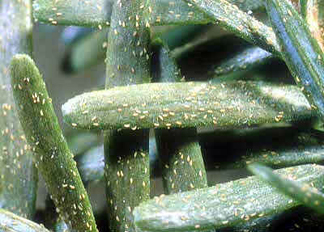Eriophyid mites on conifers
Immature and adult eriophyid mites suck on the sap in the needle. This feeding can discolor and distort foliage of many conifer species.
Editor’s note: This article is from the archives of the MSU Crop Advisory Team Alerts. Check the label of any pesticide referenced to ensure your use is included.
Immature and adult eriophyid mites suck on the sap in the needle. This feeding can discolor and distort foliage of many conifer species. Currently, we have found these mites on Fraser fir, spruce, concolor fir and hemlock, but they can also cause damage to Scotch and white pine.
When many mites are present, their damage gives the needle a dusty, bronze to rust-colored appearance. Similar damage can occur from winter injury, nutrient deficiency, drought or herbicide damage. To tell if the damage is caused by these mites, you will need to look at the needles with a hand lens and even then you may over look them if you don‘t know what your looking for. Eriophyid mites are very tiny, and have a carrot-shaped body with only four legs on one end. They can be clear, tan, cream or orange-colored.
To scout for these insects, zig-zag through your fields randomly checking trees for mites and looking for trees with bronzing or distorted foliage. Look at both the new and previous years’ growth. Often growers ask at what levels they should consider spraying. To determine if you need to treat your field, North Carolina State University recommends for hemlock west mite to keep track of the percentage of shoots that have mites, as well as the greatest number of mites on an individual needle, adding the number on both the upper and lower surface of the needle.
Treatment threshold
To determine if a pesticide is necessary, both of the following criteria must be met:
- At least 80 percent of the shoots have mites on them. In most cases, it is not necessary to treat until the majority of the trees have at least a few mites on them. This percent incidence is determined by dividing the number of shoots with at least a single mite somewhere on the shoot by the total number of shoots examined.
- There are at least eight mites on a single needle on one shoot. Only one needle on one shoot has to meet this criterion to reach treatment threshold if 80 percent incidence has been reached. Count mites both on the front side and back side of the needles to reach this sum.
Keep scouting weekly until you see mite numbers begin to decrease. This mite likes cool and dry weather and numbers can increase quickly if the conditions are right. With this past week’s hot weather, mite numbers should begin to fall off.
Products that are used to control spider mites may not control eriophyid mites that are biologically different. Successfully treating for eriophyid mites requires using a miticide effective against eriophyid mites, such as Avid (abamectin), Sevin (carbaryl) or Envidor (spirodiclofen). Remember to continue to scout trees even after treating trees to determine if mites were killed. Also, you will want to scout trees in the fall when cool temperatures return.



 Print
Print Email
Email


